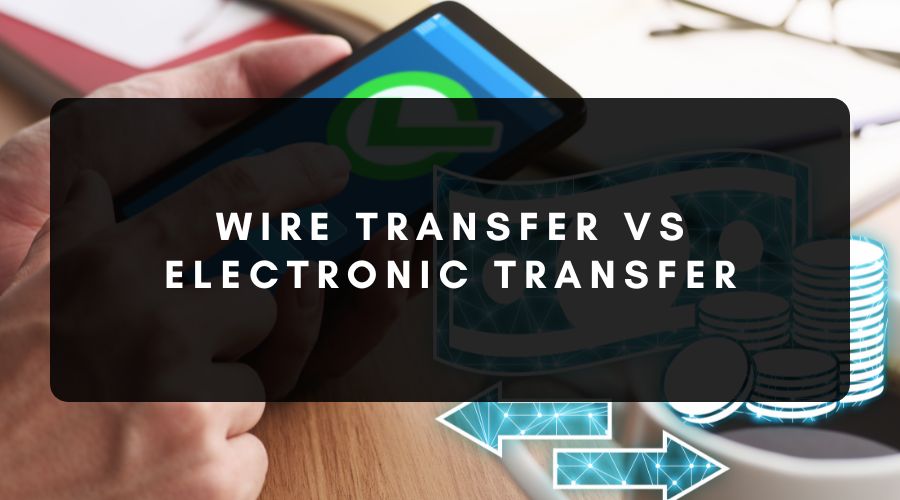
Wire Transfer vs Electronic Transfer
Understanding the difference between a wire transfer and an electronic transfer is important for businesses in an increasingly global business environment. Both payment methods offer convenience for modern businesses and consumers, but it’s important to know the differences between the two.
Transferring money using wire or electronic transfers may suit different businesses and different types of transactions. Knowing when to use each method can help you avoid late payments or getting stung by unexpected transfer fees.
What Is a Wire Transfer?
A wire transfer is a kind of electronic funds transfer in which funds are moved from one bank account to another or transferred in cash at a cash office. Bank-to-bank wire transfers are facilitated by a secure messaging system like SWIFT.
Wire transfers are convenient because they can be processed quickly and typically have much higher transaction limits than regular bank transfers. This makes them an effective payment method for transactions that involve large sums of money. Wire transfers usually come at a higher price than other payment methods because they are processed in smaller batches (although this varies from one provider to another).
How Do Wire Transfers Work?
A wire transfer order is sent through a messaging system from the sender of the funds to the recipient. Its name comes from the telegraphic wires that Western Union originally used to “wire” funds from one person to another.
To send a wire transfer, you’ll need to provide:
- The payment amount
- The sender’s bank account details
- The recipient’s bank account details
- The recipient’s contact details: name, address, and phone number
- A routing number or SWIFT code for the receiving bank (or an IBAN in Europe)
The transfer amount will be deducted from the originating account and the sender will be subject to an additional charge for the wire transfer. The recipient may also be subject to a fee by the receiving bank and any intermediary banks.
What Is an Electronic Transfer?
Electronic funds transfers (EFTs) include any electronic transfer of funds from one account to another. EFTs can be used to move funds between companies, individuals, or financial institutions and even to make bill payments.
EFTs include electronic bank transfers (such as ACH, SEPA, and EU Direct Debit), debit and credit card payments, ATM transactions, and other modern payment methods like iPhone payments. Business owners can process a wide range of electronic payment methods securely through a global payment gateway.
How Do Electronic Transfers Work?
There are two main players when sending bank-to-bank EFT payments: the account sending the money and the account receiving it. When the sender initiates the transfer and the request has been logged, the funds progress through the banking network and arrive in the receiver’s account.
Card-based EFT transactions are a little more complex because the transaction must be authorised by the customer’s bank and authenticated by the merchant in order for the funds to be transferred from the card-issuing bank to the merchant account. The steps involved in the credit card transaction process are designed to keep merchants and consumers safe.
How Long Do Electronic Transfers Take?
EFTs typically take between one and three business days to arrive. This will depend on the payment method used and the bank’s processing times.
ACH Transfers
Automated clearing house (ACH) transfers, including direct deposits and direct payments, are electronic funds transfers that are used in the United States. If your European business has a U.S. branch or operates within the U.S., it may be worth understanding how ACH payments work. The European equivalent of ACH is SEPA.
How Are Wire Transfers and Electronic Transfers Similar?
Wire transfers and electronic transfers are similar in two main ways:
They Are Both Electronic Payment Methods
EFT is an umbrella term that covers several different types of transfer. A wire transfer is a specific type of electronic payment. They also share other features:
- EFTs and wire transfers can both be used to move money domestically or internationally using an app or online portal.
- Both are secure ways to send and receive money.
Convenience
EFTs (including wire transfers) offer a more convenient alternative to manual offline transfers like cash or checks. There’s no need to go physically to the bank or speak to personnel using these payment methods. As long as you have the receiving account details, you can set up a payment quickly and easily via online banking or a third-party platform.
How Are Wire Transfers and Electronic Transfers Different?
When choosing between an electronic transfer vs wire transfer, take these key differences into account:
Processing Timeframes
If speed is your priority, wire transfers tend to be the fastest option. A domestic transfer will generally arrive on the same business day. International wire transfers or remittances usually arrive within 1-2 working days.
EFT payment processing times differ depending on the payment method you choose, the country, the time of payment, and the financial institution. Consult the relevant bank’s website for more information on processing times.
Fees
Wire transfers tend to be more expensive than EFT transfers. EFT transfers generally carry minimal or even zero fees. The cost of a wire transfer depends on how much you’re sending and the fees charged by the sending and receiving banks.
Fees for international wire transfers are generally higher. Using SEPA payments within the eurozone is a more cost-effective way to send transfers in euros. Wire transfers aren’t recommended for recurring payments like bills or utilities because of the cost.
Types of Payments
Wire transfers are fairly limited in their scope. Essentially, you have two options: domestic or international transfers.
EFTs encompass a much wider range of options. These include online banking, direct debit, in-person transactions using ATMs, debit and credit cards, and peer-to-peer payment apps.
Transfer Limits
Wire transfers generally offer a higher transfer limit than EFTs. EFT transactions generally have lower limits for how much you can send or withdraw daily, monthly, or in any given transaction.
Security
EFTs such as bank transfers are generally a safer way of sending money than wire transfers. Wire transfers are very hard to reverse if the receiving bank details are wrong. In the United States, the Electronic Fund Transfer Act (EFTA) guarantees ACH transfers (electronic bank-to-bank transfers) and card transactions but does not guarantee wire transfers.
Give Your Customers a Range of Payment Options
Working with an end-to-end payment processing company offers you and your customers the opportunity to make and receive payments via electronic transfers like SEPA, EU Direct Debit, and ACH as well as via debit and credit card payments. Modern businesses with domestic and international customers can maintain multiple sales channels and receive payments via different payment methods and in different currencies with these options.
A merchant services account with an international payment processor like Unicorn Group allows you to accept payments in more than 164 currencies and settle your earnings in any of 22 different currencies. For European businesses that foresee cross-border business, having the ability to manage multiple currencies and have all your international transactions counted towards your sales data automatically is a huge advantage.
Optimise Your Payment Methods and Costs
Your customers may have different reasons for choosing one payment method over another. Accepting a range of EFTs, including bank transfers and direct debit, is a great way to offer flexibility and choice to your customer base.
Working with a payment processor that can facilitate a wide range of EFTs is a must for modern businesses. Not only will it allow you to make more international sales but will also ensure that you can track and collate your sales data from all sources in a centralised place.

